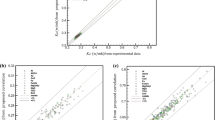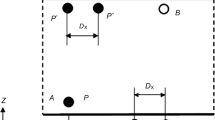Abstract
Due to the enhanced thermophysical specifications of nanofluids, such as thermal conductivity, these types of fluids are appropriate candidates for heat transfer fluids. Nanostructure dispersion in the base fluid increases the dynamic viscosity which affects fluid flow in thermal devices. In order to facilitate design of thermal devices, it is crucial to have accurate predictive models for thermophysical properties of nanofluids. Dimensions of nanoparticles, working temperature and the concentration of nano-sized particles in the fluid are among the most influential factors in predicting dynamic viscosity of nanofluids. In the present research, four LSSVM-based algorithms including GA-LSSVM, PSO-LSSVM, HGAPSO-LSSVM and ICA-LSSVM are employed to model the dynamic viscosity of Al2O3/water. Results revealed that the generated models are accurate tools to calculate the dynamic viscosity of the nanofluid on the basis of the mentioned variables. The highest obtained coefficient of correlation belongs to GA-LSSVM which is equal to 0.9871, while this value for PSO-LSSVM, HGAPSO-LSSVM, and ICA-LSSVM algorithms are 0.9855, 0.9855, and 0.9846, respectively. Another utilized criterion for evaluating model accuracy is MSE value. Results revealed that the MSE values for HGAPSO-LSSVM, GA-LSSVM, PSO-LSSVM, and ICA-LSSVM are 0.00854, 0.00855, 0.00896 and 0.00979, respectively.















Similar content being viewed by others
References
Hussein AK, Li D, Kolsi L, Kata S, Sahoo B. A review of nano fluid role to improve the performance of the heat pipe solar collectors. Energy Procedia. 2017;109:417–24. https://doi.org/10.1016/J.EGYPRO.2017.03.044.
Akbarianrad N, Mohammadian F, Alhuyi Nazari M, Rahbani Nobar B. Applications of nanotechnology in endodontic: a review. Nanomed J. 2018;5:121–6. https://doi.org/10.22038/NMJ.2018.005.0001.
Mohammadi M, Mohammadi M, Shafii MB. Experimental investigation of a pulsating heat pipe using ferrofluid (magnetic nanofluid). J Heat Transf. 2012;134:014504. https://doi.org/10.1115/1.4004805.
Aramesh M, Pourfayaz F, Kasaeian A. Numerical investigation of the nanofluid effects on the heat extraction process of solar ponds in the transient step. Sol Energy. 2017;157:869–79. https://doi.org/10.1016/J.SOLENER.2017.09.011.
Haghighi Bardineh Y, Mohamadian F, Ahmadi MH, Akbarianrad N. Medical and dental applications of renewable energy systems. Int J Low Carbon Technol. 2018. https://doi.org/10.1093/ijlct/cty040.
Zarringhalam M, Karimipour A, Toghraie D. Experimental study of the effect of solid volume fraction and Reynolds number on heat transfer coefficient and pressure drop of CuO–Water nanofluid. Exp Therm Fluid Sci. 2016;76:342–51. https://doi.org/10.1016/J.EXPTHERMFLUSCI.2016.03.026.
Leong KY, Saidur R, Mahlia TMI, Yau YH. Performance investigation of nanofluids as working fluid in a thermosyphon air preheater. Int Commun Heat Mass Transf. 2012;39:523–9. https://doi.org/10.1016/j.icheatmasstransfer.2012.01.014.
Esfahani MR, Languri EM, Nunna MR. Effect of particle size and viscosity on thermal conductivity enhancement of graphene oxide nanofluid. Int Commun Heat Mass Transf. 2016;76:308–15. https://doi.org/10.1016/j.icheatmasstransfer.2016.06.006.
Nazari MA, Ghasempour R, Ahmadi MH, Heydarian G, Shafii MB. Experimental investigation of graphene oxide nanofluid on heat transfer enhancement of pulsating heat pipe. Int Commun Heat Mass Transf. 2018;91:90–4. https://doi.org/10.1016/j.icheatmasstransfer.2017.12.006.
Gandomkar A, Saidi MH, Shafii MB, Vandadi M, Kalan K. Visualization and comparative investigations of pulsating ferro-fluid heat pipe. Appl Therm Eng. 2017;116:56–65. https://doi.org/10.1016/J.APPLTHERMALENG.2017.01.068.
Alhuyi Nazari M, Ahmadi MH, Ghasempour R, Shafii MB. How to improve the thermal performance of pulsating heat pipes: a review on working fluid. Renew Sustain Energy Rev. 2018;91:630–8. https://doi.org/10.1016/j.rser.2018.04.042.
Ahmadi MH, Ahmadi MA, Nazari MA, Mahian O, Ghasempour R. A proposed model to predict thermal conductivity ratio of Al2O3/EG nanofluid by applying least squares support vector machine (LSSVM) and genetic algorithm as a connectionist approach. J Therm Anal Calorim. 2018. https://doi.org/10.1007/s10973-018-7035-z.
Hemmat Esfe M, Abbasian Arani AA, Shafiei Badi R, Rejvani M. ANN modeling, cost performance and sensitivity analyzing of thermal conductivity of DWCNT–SiO2/EG hybrid nanofluid for higher heat transfer. J Therm Anal Calorim. 2018;131:2381–93. https://doi.org/10.1007/s10973-017-6744-z.
Shamaeil M, Firouzi M, Fakhar A. The effects of temperature and volume fraction on the thermal conductivity of functionalized DWCNTs/ethylene glycol nanofluid. J Therm Anal Calorim. 2016;126:1455–62. https://doi.org/10.1007/s10973-016-5548-x.
Karimipour A, Alipour H, Ali Akbari O, Toghraie Semiromi D, Hemmat Esfe M. Studying the effect of indentation on flow parameters and slow heat transfer of water–silver nano-fluid with varying volume fraction in a rectangular two-dimensional micro channel. Indian J Sci Technol. 2015. https://doi.org/10.17485/ijst/2015/v8i15/51707.
Akbari OA, Safaei MR, Goodarzi M, Akbar NS, Zarringhalam M, Shabani GAS, et al. A modified two-phase mixture model of nanofluid flow and heat transfer in a 3-D curved microtube. Adv Powder Technol. 2016;27:2175–85. https://doi.org/10.1016/J.APT.2016.08.002.
Akbari OA, Toghraie D, Karimipour A, Marzban A, Ahmadi GR. The effect of velocity and dimension of solid nanoparticles on heat transfer in non-Newtonian nanofluid. Phys E Low Dimens Syst Nanostruct. 2017;86:68–75. https://doi.org/10.1016/J.PHYSE.2016.10.013.
Esfahani MA, Toghraie D. Experimental investigation for developing a new model for the thermal conductivity of silica/water-ethylene glycol (40%–60%) nano fluid at different temperatures and solid volume fractions. J Mol Liq. 2017;232:105–12. https://doi.org/10.1016/j.molliq.2017.02.037.
Ahmadi M-A, Ahmadi MH, Fahim Alavi M, Nazemzadegan MR, Ghasempour R, Shamshirband S. Determination of thermal conductivity ratio of CuO/ethylene glycol nanofluid by connectionist approach. J Taiwan Inst Chem Eng. 2018;9:383–95. https://doi.org/10.1016/J.JTICE.2018.06.003.
Alawi OA, Sidik NAC, Xian HW, Kean TH, Kazi SN. Thermal conductivity and viscosity models of metallic oxides nanofluids. Int J Heat Mass Transf. 2018;116:1314–25. https://doi.org/10.1016/J.IJHEATMASSTRANSFER.2017.09.133.
Ahmadi MH, Mirlohi A, Nazari MA, Ghasempour R. A review of thermal conductivity of various nanofluids. J Mol Liq. 2018. https://doi.org/10.1016/j.molliq.2018.05.124.
Hemmat Esfe M, Abbasian Arani AA, Rezaie M, Yan W-M, Karimipour A. Experimental determination of thermal conductivity and dynamic viscosity of Ag–MgO/water hybrid nanofluid. Int Commun Heat Mass Transf. 2015;66:189–95. https://doi.org/10.1016/J.ICHEATMASSTRANSFER.2015.06.003.
Alirezaie A, Saedodin S, Esfe MH, Rostamian SH. Investigation of rheological behavior of MWCNT (COOH-functionalized)/MgO—engine oil hybrid nanofluids and modelling the results with artificial neural networks. J Mol Liq. 2017;241:173–81. https://doi.org/10.1016/J.MOLLIQ.2017.05.121.
Toghyani S, Ahmadi MH, Kasaeian A, Mohammadi AH. Artificial neural network, ANN-PSO and ANN-ICA for modelling the Stirling engine. Int J Ambient Energy. 2016;37:456–68. https://doi.org/10.1080/01430750.2014.986289.
Ahmadi MH, Ahmadi MA, Sadatsakkak SA, Feidt M. Connectionist intelligent model estimates output power and torque of stirling engine. Renew Sustain Energy Rev. 2015;50:871–83. https://doi.org/10.1016/J.RSER.2015.04.185.
Mohamadian F, Eftekhar L, Haghighi Bardineh Y. Applying GMDH artificial neural network to predict dynamic viscosity of an antimicrobial nanofluid. Nanomed J. 2018;5:217–21. https://doi.org/10.22038/NMJ.2018.05.00005.
Hemmat Esfe M, Esfandeh S, Rejvani M. Modeling of thermal conductivity of MWCNT–SiO2 (30:70%)/EG hybrid nanofluid, sensitivity analyzing and cost performance for industrial applications. J Therm Anal Calorim. 2018;131:1437–47. https://doi.org/10.1007/s10973-017-6680-y.
Esfe MH, Rejvani M, Karimpour R, Abbasian Arani AA. Estimation of thermal conductivity of ethylene glycol-based nanofluid with hybrid suspensions of SWCNT–Al2O3 nanoparticles by correlation and ANN methods using experimental data. J Therm Anal Calorim. 2017;128:1359–71. https://doi.org/10.1007/s10973-016-6002-9.
Hemmat Esfe M, Saedodin S, Akbari M, Karimipour A, Afrand M, Wongwises S, et al. Experimental investigation and development of new correlations for thermal conductivity of CuO/EG–water nanofluid. Int Commun Heat Mass Transf. 2015;65:47–51. https://doi.org/10.1016/J.ICHEATMASSTRANSFER.2015.04.006.
Loni R, Kasaeian A, Shahverdi K, Askari Asli-Ardeh E, Ghobadian B, Ahmadi MH. ANN model to predict the performance of parabolic dish collector with tubular cavity receiver. Mech Ind. 2017;18:408. https://doi.org/10.1051/meca/2017016.
Ahmadi MH, Ahmadi MA, Ashouri M, Razie Astaraei F, Ghasempour R, Aloui F. Prediction of performance of Stirling engine using least squares support machine technique. Mech Ind. 2016;17:506. https://doi.org/10.1051/meca/2015098.
Ahmadi MH, Nazari MA, Ghasempour R, Madah H, Shafii MB, Ahmadi MA. Thermal conductivity ratio prediction of Al2O3/water nanofluid by applying connectionist methods. Colloids Surf A Physicochem Eng Asp. 2018;541:154–64. https://doi.org/10.1016/j.colsurfa.2018.01.030.
Suykens JAK, Van Gestel T, De Brabanter J, De Moor B, Vandewalle J. Least squares support vector machines. Singapore: World Scientific; 2002. https://doi.org/10.1142/5089.
Ahmadi MA, Mahmoudi B. Development of robust model to estimate gas–oil interfacial tension using least square support vector machine: experimental and modeling study. J Supercrit Fluids. 2016;107:122–8. https://doi.org/10.1016/J.SUPFLU.2015.08.012.
van Gestel T, Suykens JAK, Baesens B, Viaene S, Vanthienen J, Dedene G, et al. Benchmarking least squares support vector machine classifiers. Mach Learn. 2004;54:5–32. https://doi.org/10.1023/B:MACH.0000008082.80494.e0.
Ahmadi MA, Ebadi M. Evolving smart approach for determination dew point pressure through condensate gas reservoirs. Fuel. 2014;117:1074–84. https://doi.org/10.1016/J.FUEL.2013.10.010.
Cortes C, Vapnik V. Support-vector networks. Mach Learn. 1995;20:273–97. https://doi.org/10.1007/BF00994018.
Pelckmans K, Suykens JAK, Gestel T Van, De Brabanter J, Lukas L, Hamers B, et al. LS-SVMlab: a MATLAB/C toolbox for least squares support vector machines. n.d.
Ahmadi M-A, Bahadori A. A LSSVM approach for determining well placement and conning phenomena in horizontal wells. Fuel. 2015;153:276–83. https://doi.org/10.1016/J.FUEL.2015.02.094.
Baghban A, Kardani MN, Habibzadeh S. Prediction viscosity of ionic liquids using a hybrid LSSVM and group contribution method. J Mol Liq. 2017;236:452–64. https://doi.org/10.1016/j.molliq.2017.04.019.
Ahmadi MA, Zendehboudi S, James LA. Developing a robust proxy model of CO2 injection: coupling Box–Behnken design and a connectionist method. Fuel. 2018;215:904–14. https://doi.org/10.1016/j.fuel.2017.11.030.
Ahmadi MA, Chen Z. Comparison of machine learning methods for estimating permeability and porosity of oil reservoirs via petro-physical logs. Petroleum. 2018. https://doi.org/10.1016/j.petlm.2018.06.002.
Nguyen CT, Desgranges F, Roy G, Galanis N, Maré T, Boucher S, et al. Temperature and particle-size dependent viscosity data for water-based nanofluids—hysteresis phenomenon. Int J Heat Fluid Flow. 2007;28:1492–506. https://doi.org/10.1016/J.IJHEATFLUIDFLOW.2007.02.004.
Lee J-H, Hwang KS, Jang SP, Lee BH, Kim JH, Choi SUS, et al. Effective viscosities and thermal conductivities of aqueous nanofluids containing low volume concentrations of Al2O3 nanoparticles. Int J Heat Mass Transf. 2008;51:2651–6. https://doi.org/10.1016/J.IJHEATMASSTRANSFER.2007.10.026.
Author information
Authors and Affiliations
Corresponding author
Rights and permissions
About this article
Cite this article
Ramezanizadeh, M., Ahmadi, M.A., Ahmadi, M.H. et al. Rigorous smart model for predicting dynamic viscosity of Al2O3/water nanofluid. J Therm Anal Calorim 137, 307–316 (2019). https://doi.org/10.1007/s10973-018-7916-1
Received:
Accepted:
Published:
Issue Date:
DOI: https://doi.org/10.1007/s10973-018-7916-1




